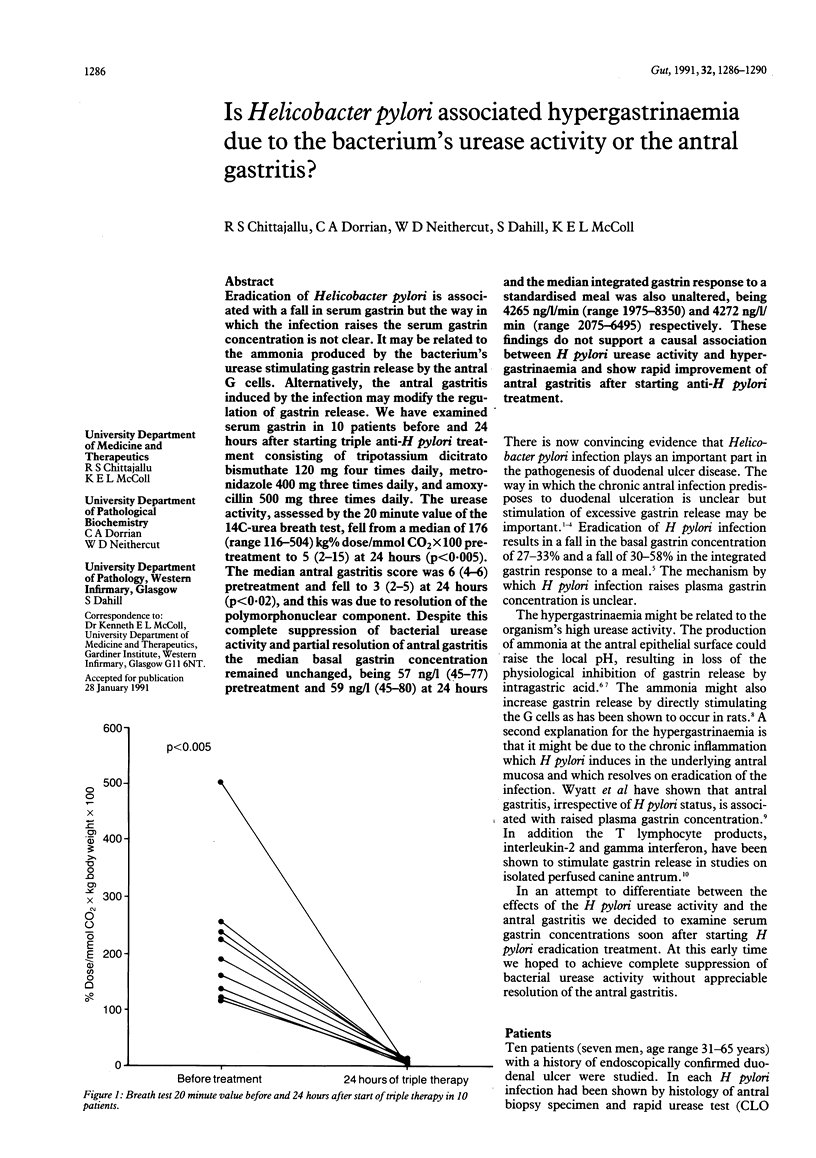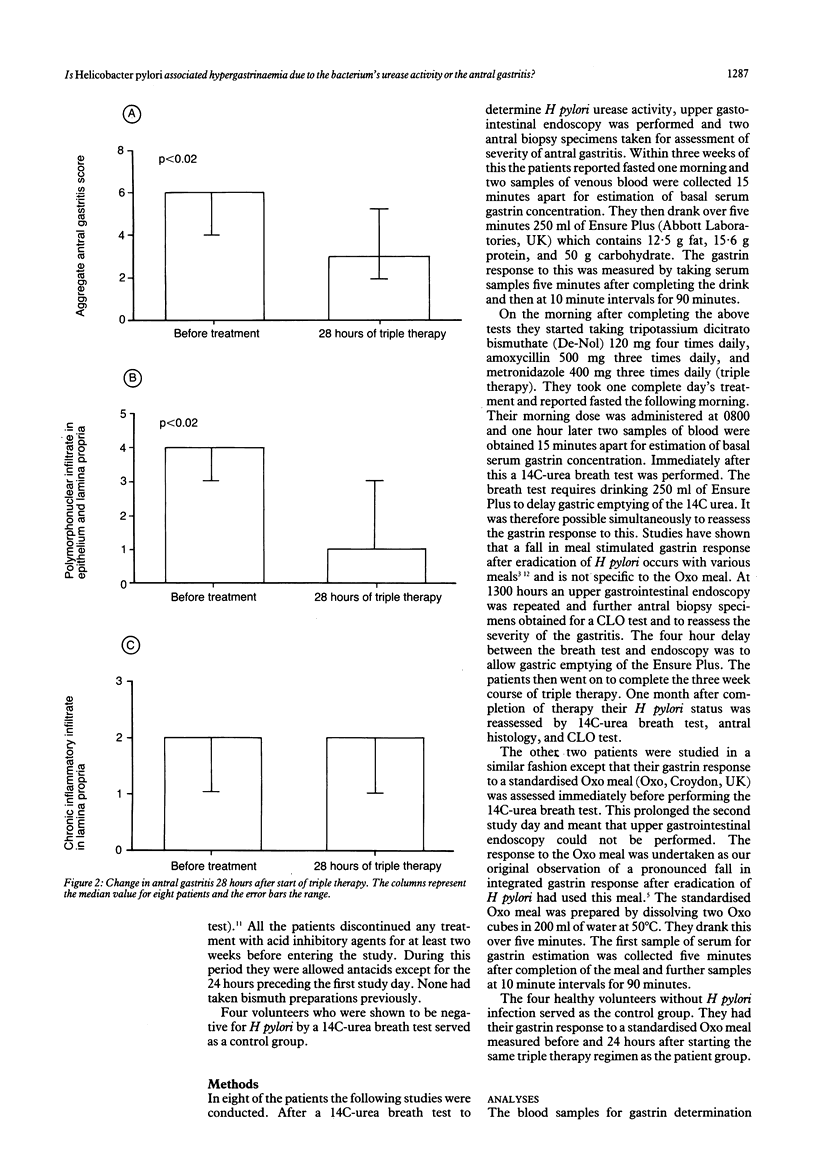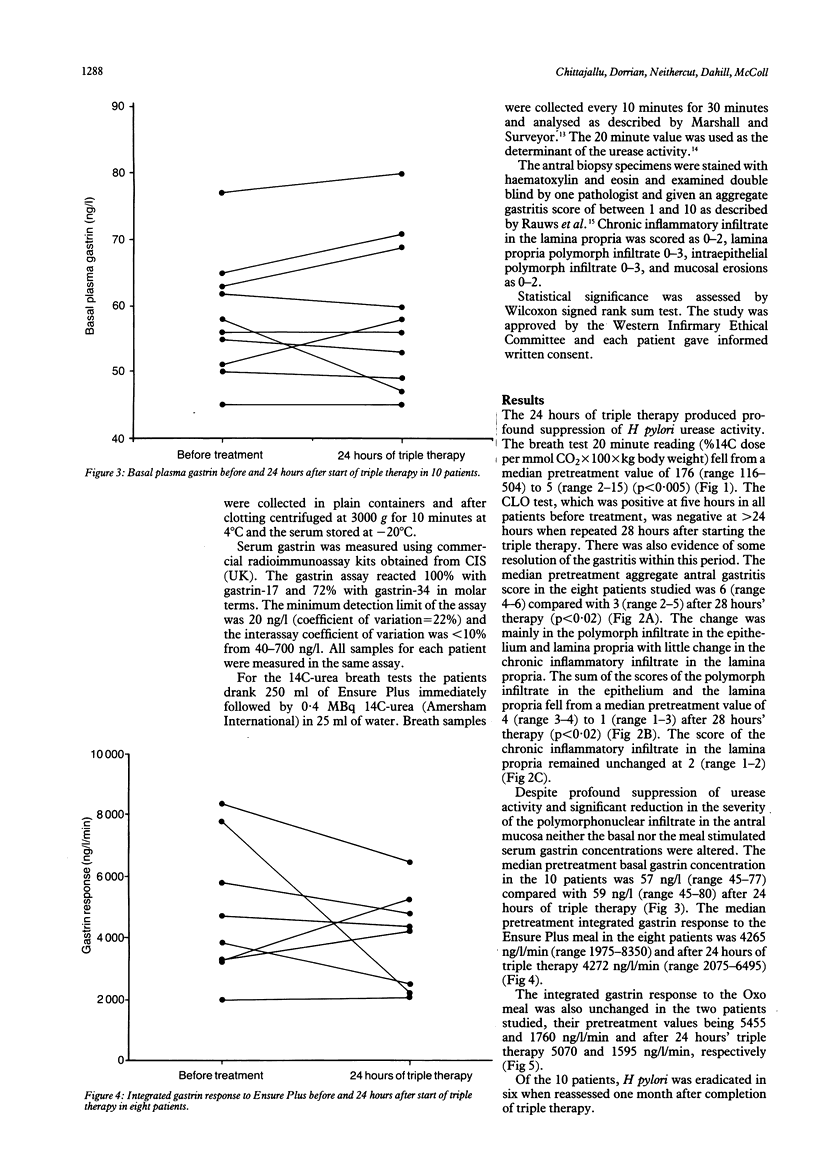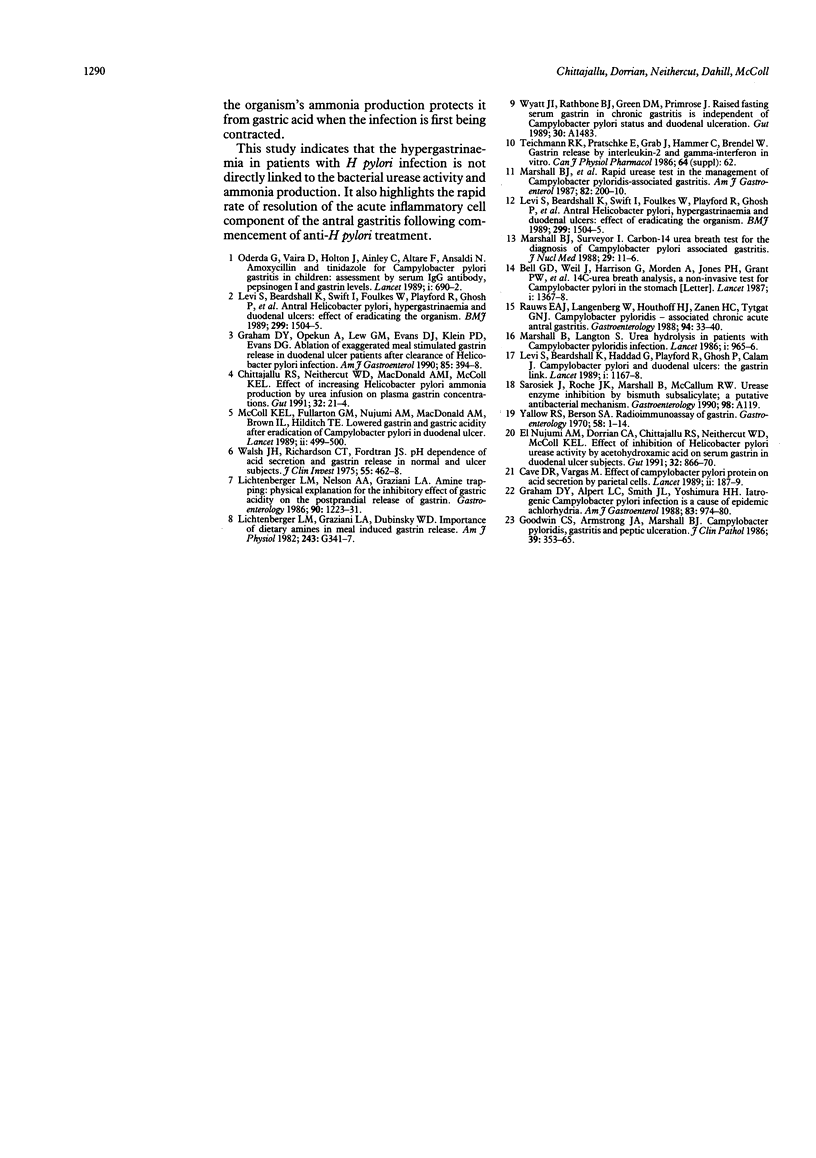Abstract
Eradication of Helicobacter pylori is associated with a fall in serum gastrin but the way in which the infection raises the serum gastrin concentration is not clear. It may be related to the ammonia produced by the bacterium's urease stimulating gastrin release by the antral G cells. Alternatively, the antral gastritis induced by the infection may modify the regulation of gastrin release. We have examined serum gastrin in 10 patients before and 24 hours after starting triple anti-H pylori treatment consisting of tripotassium dicitrato bismuthate 120 mg four times daily, metronidazole 400 mg three times daily, and amoxycillin 500 mg three times daily. The urease activity, assessed by the 20 minute value of the 14C-urea breath test, fell from a median of 176 (range 116-504) kg% dose/mmol CO2 x 100 pretreatment to 5 (2-15) at 24 hours (p less than 0.005). The median antral gastritis score was 6 (4-6) pretreatment and fell to 3 (2-5) at 24 hours (p less than 0.02), and this was due to resolution of the polymorphonuclear component. Despite this complete suppression of bacterial urease activity and partial resolution of antral gastritis the median basal gastrin concentration remained unchanged, being 57 ng/l (45-77) pretreatment and 59 ng/l (45-80) at 24 hours and the median integrated gastrin response to a standardised meal was also unaltered, being 4265 ng/l/min (range 1975-8350) and 4272 ng/l/min (range 2075-6495) respectively. These findings do not support a causal association between H pylori urease activity and hypergastrinaemia and show rapid improvement of antral gastritis after starting anti-H pylori treatment.
Full text
PDF




Selected References
These references are in PubMed. This may not be the complete list of references from this article.
- Bell G. D., Weil J., Harrison G., Morden A., Jones P. H., Gant P. W., Trowell J. E., Yoong A. K., Daneshmend T. K., Logan R. F. 14C-urea breath analysis, a non-invasive test for Campylobacter pylori in the stomach. Lancet. 1987 Jun 13;1(8546):1367–1368. doi: 10.1016/s0140-6736(87)90664-7. [DOI] [PubMed] [Google Scholar]
- Cave D. R., Vargas M. Effect of a Campylobacter pylori protein on acid secretion by parietal cells. Lancet. 1989 Jul 22;2(8656):187–189. doi: 10.1016/s0140-6736(89)90372-3. [DOI] [PubMed] [Google Scholar]
- Chittajallu R. S., Neithercut W. D., Macdonald A. M., McColl K. E. Effect of increasing Helicobacter pylori ammonia production by urea infusion on plasma gastrin concentrations. Gut. 1991 Jan;32(1):21–24. doi: 10.1136/gut.32.1.21. [DOI] [PMC free article] [PubMed] [Google Scholar]
- Goodwin C. S., Armstrong J. A., Marshall B. J. Campylobacter pyloridis, gastritis, and peptic ulceration. J Clin Pathol. 1986 Apr;39(4):353–365. doi: 10.1136/jcp.39.4.353. [DOI] [PMC free article] [PubMed] [Google Scholar]
- Graham D. Y., Alpert L. C., Smith J. L., Yoshimura H. H. Iatrogenic Campylobacter pylori infection is a cause of epidemic achlorhydria. Am J Gastroenterol. 1988 Sep;83(9):974–980. [PubMed] [Google Scholar]
- Graham D. Y., Opekun A., Lew G. M., Evans D. J., Jr, Klein P. D., Evans D. G. Ablation of exaggerated meal-stimulated gastrin release in duodenal ulcer patients after clearance of Helicobacter (Campylobacter) pylori infection. Am J Gastroenterol. 1990 Apr;85(4):394–398. [PubMed] [Google Scholar]
- Levi S., Beardshall K., Haddad G., Playford R., Ghosh P., Calam J. Campylobacter pylori and duodenal ulcers: the gastrin link. Lancet. 1989 May 27;1(8648):1167–1168. doi: 10.1016/s0140-6736(89)92752-9. [DOI] [PubMed] [Google Scholar]
- Levi S., Beardshall K., Swift I., Foulkes W., Playford R., Ghosh P., Calam J. Antral Helicobacter pylori, hypergastrinaemia, and duodenal ulcers: effect of eradicating the organism. BMJ. 1989 Dec 16;299(6714):1504–1505. doi: 10.1136/bmj.299.6714.1504. [DOI] [PMC free article] [PubMed] [Google Scholar]
- Levi S., Beardshall K., Swift I., Foulkes W., Playford R., Ghosh P., Calam J. Antral Helicobacter pylori, hypergastrinaemia, and duodenal ulcers: effect of eradicating the organism. BMJ. 1989 Dec 16;299(6714):1504–1505. doi: 10.1136/bmj.299.6714.1504. [DOI] [PMC free article] [PubMed] [Google Scholar]
- Lichtenberger L. M., Graziani L. A., Dubinsky W. P. Importance of dietary amines in meal-induced gastrin release. Am J Physiol. 1982 Nov;243(5):G341–G347. doi: 10.1152/ajpgi.1982.243.5.G341. [DOI] [PubMed] [Google Scholar]
- Lichtenberger L. M., Nelson A. A., Graziani L. A. Amine trapping: physical explanation for the inhibitory effect of gastric acidity on the postprandial release of gastrin. Studies on rats and dogs. Gastroenterology. 1986 May;90(5 Pt 1):1223–1231. doi: 10.1016/0016-5085(86)90389-6. [DOI] [PubMed] [Google Scholar]
- Marshall B. J., Langton S. R. Urea hydrolysis in patients with Campylobacter pyloridis infection. Lancet. 1986 Apr 26;1(8487):965–966. doi: 10.1016/s0140-6736(86)91060-3. [DOI] [PubMed] [Google Scholar]
- Marshall B. J., Surveyor I. Carbon-14 urea breath test for the diagnosis of Campylobacter pylori associated gastritis. J Nucl Med. 1988 Jan;29(1):11–16. [PubMed] [Google Scholar]
- Marshall B. J., Warren J. R., Francis G. J., Langton S. R., Goodwin C. S., Blincow E. D. Rapid urease test in the management of Campylobacter pyloridis-associated gastritis. Am J Gastroenterol. 1987 Mar;82(3):200–210. [PubMed] [Google Scholar]
- McColl K. E., Fullarton G. M., el Nujumi A. M., Macdonald A. M., Brown I. L., Hilditch T. E. Lowered gastrin and gastric acidity after eradication of Campylobacter pylori in duodenal ulcer. Lancet. 1989 Aug 26;2(8661):499–500. doi: 10.1016/s0140-6736(89)92105-3. [DOI] [PubMed] [Google Scholar]
- Oderda G., Vaira D., Holton J., Ainley C., Altare F., Ansaldi N. Amoxycillin plus tinidazole for Campylobacter pylori gastritis in children: assessment by serum IgG antibody, pepsinogen I, and gastrin levels. Lancet. 1989 Apr 1;1(8640):690–692. doi: 10.1016/s0140-6736(89)92206-x. [DOI] [PubMed] [Google Scholar]
- Rauws E. A., Langenberg W., Houthoff H. J., Zanen H. C., Tytgat G. N. Campylobacter pyloridis-associated chronic active antral gastritis. A prospective study of its prevalence and the effects of antibacterial and antiulcer treatment. Gastroenterology. 1988 Jan;94(1):33–40. [PubMed] [Google Scholar]
- Walsh J. H., Richardson C. T., Fordtran J. S. pH dependence of acid secretion and gastrin release in normal and ulcer subjects. J Clin Invest. 1975 Mar;55(3):462–468. doi: 10.1172/JCI107952. [DOI] [PMC free article] [PubMed] [Google Scholar]
- Wilson D. R., Honrath U., Sonnenberg H. Effect of acetylcholine and secretin on medullary collecting duct function in the rat. Can J Physiol Pharmacol. 1986 Jan;64(1):62–65. doi: 10.1139/y86-009. [DOI] [PubMed] [Google Scholar]
- Yalow R. S., Berson S. A. Radioimmunoassay of gastrin. Gastroenterology. 1970 Jan;58(1):1–14. [PubMed] [Google Scholar]
- el Nujumi A. M., Dorrian C. A., Chittajallu R. S., Neithercut W. D., McColl K. E. Effect of inhibition of Helicobacter pylori urease activity by acetohydroxamic acid on serum gastrin in duodenal ulcer subjects. Gut. 1991 Aug;32(8):866–870. doi: 10.1136/gut.32.8.866. [DOI] [PMC free article] [PubMed] [Google Scholar]


